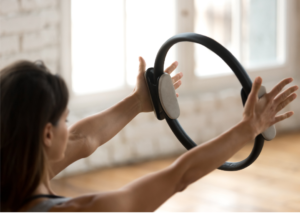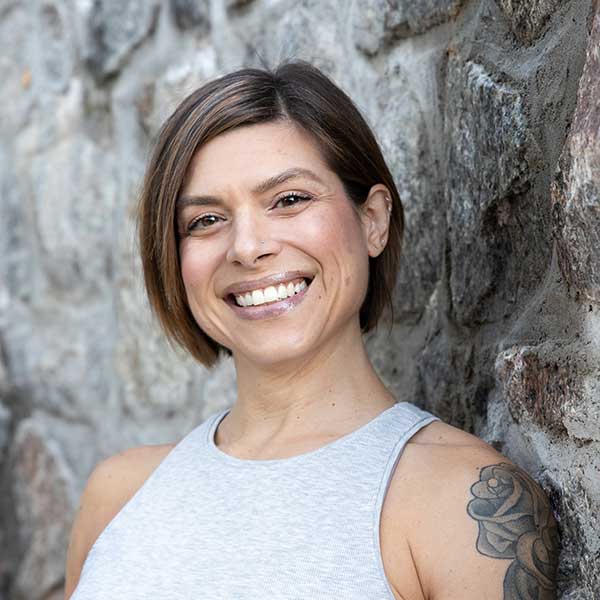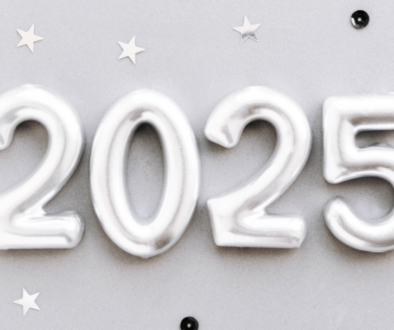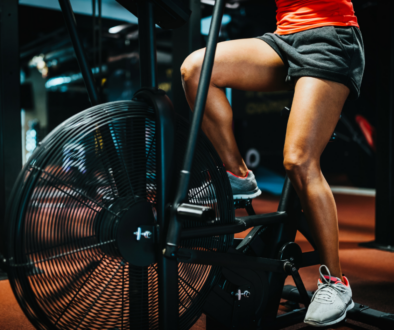8 Reasons Why You Should Do Pilates
 Flashback 17 years ago: I was teaching Cardio Kickboxing and Cycling and strength training on the machines at the gym and I was always sore. I remember hobbling down the stairs leaving the gym one day. You know the way you do two or three days following a good leg day? Only I hobbled down those stairs after every workout. That day, I thought to myself, this isn’t comfortable and it’s not attractive. And a big part of the reason I was working out was because I wanted to look good. I knew I was missing something.
Flashback 17 years ago: I was teaching Cardio Kickboxing and Cycling and strength training on the machines at the gym and I was always sore. I remember hobbling down the stairs leaving the gym one day. You know the way you do two or three days following a good leg day? Only I hobbled down those stairs after every workout. That day, I thought to myself, this isn’t comfortable and it’s not attractive. And a big part of the reason I was working out was because I wanted to look good. I knew I was missing something.
The next day, I saw the Pilates instructor walking through the gym. She looked like she was floating. She had great posture and moved effortlessly. I decided Pilates was what I needed, and I started taking her classes. I got so much benefit from Pilates that I started teaching it two years later. Here’s why I love Pilates, why I continue to practice and teach it, and why you should do Pilates.
1. You’ll Look Leaner
If you have an anterior pelvic tilt (like I do), not only can that contribute to low back pain, but it can make your abdominals “stick out.” If you want to look leaner through your mid-section, Pilates is key because of all of the exercise where you’re “imprinting” your spine into the mat. Those exercises can help correct this imbalance making you look and feel better.
2. You’ll Stay Active Daily
Pilates is a low-intensity form of exercise you can do between higher-intensity workouts like strength training and cardiorespiratory training. Pilates can help you recover from these workouts. And by mixing in lower-intensity workouts like Pilates, you’re able to exercise daily without overtraining and burning out. Daily exercise is important to overall healthy, weight maintenance, and emotional well-being.
3. You’ll Stay Mobile
Even if you’re already stretching and working on your flexibility, that’s not the same as mobility. Mobility is active and flexibility is passive. Mobility requires flexibility PLUS strength and stability. For example, you may be able to pull your leg stretch into a stretch with the help of your hands or a strap, but can you actually keep your leg straight as you move through exercises for several repetitions? Mobility (unlike flexibility) is what you need to stay active, mobile, and injury-free in the movements you make all day long off the mat.
4. You’ll Strengthen Your Core
You know you need a strong core. The core is more than just your abdominal muscles. It’s everything from your shoulders to your hips. I like to say your core as two jobs: movement and stability (stability is also called anti-movement). And its most important job is stability or resisting movements. Sit ups and crunches alone aren’t effective because those train flexion, which is only one of the four core movements. And they don’t train stability or the 4 core anti-movements at all. Pilates is the Queen when it comes to teaching stability. The point of many of the exercises is to be able to do them without shifting or rocking through the hips or upper body and without any pooching or poking of the abdominals. This point is easy to miss. And anybody who says a Pilates class was “too easy” missed the point. The stability you learn in Pilates will transfer beautifully to heavy strength training exercises that demand a strong stable core and to the movements you make at home or in the yard.
5. You’ll Improve Your Posture
Thanks in part to technology, we’re all walking around with poor posture: forward head, slumped shoulders, and a rounded upper back. This causes pain in the neck, can lead to shoulder injuries, it restricts breathing, and let’s be honest, it’s not attractive. Remember that when Joseph Pilates brought his method (then called Contrology) to New York in the early 20th century, ballerinas loved it. Visualize the posture of a ballerina. No shoulders hiked up the ears. No dowagers hump in the upper back. And they make everything look so easy. In Pilates, there’s no grunting and no muscling through sloppy repetitions. You’ll be reminded often to breathe, pull your shoulders away from your ears, and lengthen your spine. And when you practice with good posture on the mat, you’ll have good posture all day long.
6. It’s Good for Balance
Balance and fall prevention are big goals for many of my clients. One of the worst things we’ve done for balance is spend all our time including our workouts in restrictive, overly padded shoes. If you’ve ever worn a cast on an arm or leg, you know the muscles atrophy. That’s basically what we’ve been doing to our feet. As a result of wearing shoes and not properly exercising the feet, you’re losing neuromuscular connection (either you can’t move your toes, or you literally can’t feel your feet anymore) and you’ve lost strength and mobility through the foot and ankle. This puts you at greater risk for falling. You need to strengthen your feet by working out barefoot. It’s not practical or safe to do cardiorespiratory training or to walk outside barefoot. You may be able to strength train bare foot if you’re working out at home, as I encourage all my online clients to do. But you definitely need barefoot training in your routine. Pilates is great training for your feet. You’re barefoot and there’s a lot of pointing and flexing, and even some standing and single leg standing exercises that specifically focus on balance.
7. You’ll Alleviate Back Pain
If you have back pain, Pilates is a must in your weekly routine. And this isn’t just the opinion of someone with back pain who’s been practicing for 17 years and teaching for 15, there are studies that support this. Pilates a very unique form of exercise because of everything already mentioned: you are training with proper alignment and good posture, it’s no-impact, it’s not too intense, you’re improving functional mobility and core stability, and there’s a big emphasis on breathing, awareness, and technique. Turns out, all things that are great for managing back pain.
8. You Can Do Pilates Forever
There’s a reason why women and men in their 50’s, 60’s, 70’s, and beyond love Pilates. It’s a form of exercise you can do in every decade of life. You can modify and adapt exercises or progress and challenge yourself as needed depending on how your body is feeling day to day. There are so many different exercise variations and there is equipment (like weighted balls, the Pilates Ring, core ball, and bands) that you can use to make exercises easier, more difficult, or just new and different. And a good teacher keeps it fun and interesting and offers you the freedom to customize your practice. You can continue to benefit from Pilates for a lifetime.
Now you know why you should do Pilates. So take off your shoes, grab a mat, and let’s do it!
This post contains Amazon affiliate links.



